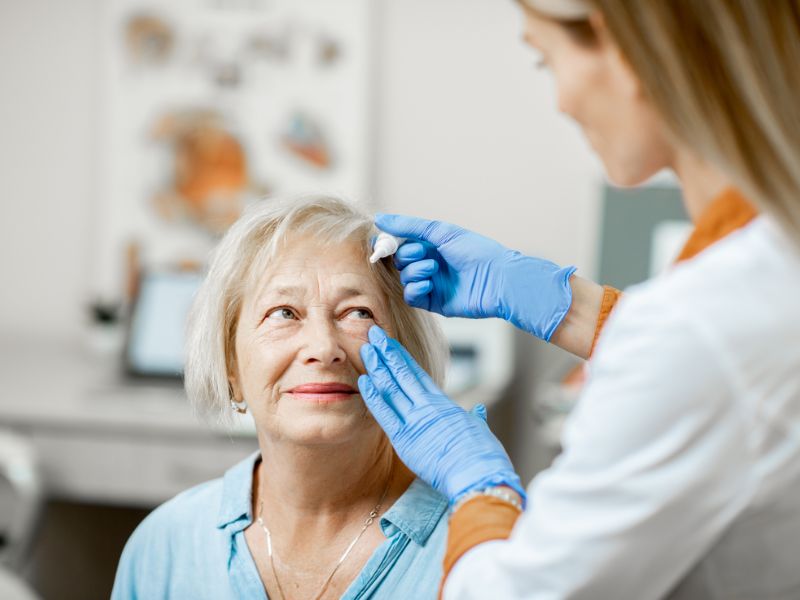Diabetes is a complicated disease that impacts far more than just your blood sugar. If not well-controlled, diabetes can lead to serious complications in many areas of your health – including your eyes.
As part of National Diabetic Eye Disease Month this November, it’s a great time to learn how diabetes can impact your eye health and what you can do to protect your vision. Diabetes affects millions of people in the U.S., and diabetic eye disease is the leading cause of blindness in American adults. But don’t worry—we’re here to help you understand what diabetic eye disease is, why it happens, and how you can prevent it.
What is Diabetic Eye Disease?
Diabetic eye disease isn’t just one condition – it’s a group of eye problems that affect people with diabetes. The most common types include:
- Diabetic Retinopathy: This is the most common diabetic eye disease; about one in three diabetics over the age of 40 already have signs of the condition. It occurs when high blood sugar levels damage the blood vessels in the retina (the light-sensitive tissue at the back of your eye.) Over time, these blood vessels can become leaky, swell, or even close off entirely, disrupting the normal function of the retina. This can lead to vision problems such as blurry vision, floaters, dark spots in your field of vision, or even permanent blindness if left untreated.
- Diabetic Macular Edema (DME): This condition often develops along with diabetic retinopathy. It happens when fluid leaks into the macula (the part of the retina responsible for sharp, central vision), causing it to swell. This can lead to blurred or distorted vision, making it difficult to perform tasks like reading, driving, or recognizing faces.
- Cataracts: While cataracts can happen to anyone as they age, people with diabetes are more likely to develop them earlier. A cataract is a clouding of your eye’s natural lens, leading to blurry vision, glare, and difficulty seeing colors.
- Glaucoma: This group of eye conditions damages the optic nerve, often due to increased pressure inside the eye. Diabetes doubles the risk of developing glaucoma, which can lead to vision loss if not treated early.
Why Does It Happen?
High glucose can cause changes in the fluid levels and delicate tissues of your eyes that help you see clearly. Most diabetics experience episodes of temporary vision changes, especially when making changes to medications or care plans.
But over time, consistent high blood sugar levels will damage the tiny blood vessels in the back of your eyes, which begin to leak and swell. Most serious diabetic eye diseases begin with blood vessel damage. This damage often starts during prediabetes and without any symptoms, which is why diabetic eye disease can sneak up on you.
Some people are at higher risk of diabetic eye disease than others. Factors that can increase your risk include:
- High blood sugar that is not treated
- High blood pressure or cholesterol
- Smoking
- Pregnancy
- Age
What Does It Mean for You?
If you have diabetes, especially if you’ve had it for a long time, your risk of developing diabetic eye disease increases. While not everyone will experience eye issues, it’s important to stay vigilant about eye health and regularly see an eye doctor. Early detection and proper management can prevent or slow the progression of these conditions.
How Can You Prevent Diabetic Eye Disease?
Fortunately, there are steps you can take to protect your eyes:
- Keep your blood sugar in check: Managing your blood sugar levels is the best way to prevent damage to the eyes and other parts of the body.
- Maintain healthy blood pressure and cholesterol levels: These factors can also contribute to eye damage, so keep them in a healthy range.
- Have a yearly dilated eye exam: Your eye doctor can spot early signs of diabetic retinopathy before you notice any symptoms.
- Quit smoking: Smoking can increase your risk of eye disease, as well as other diabetes complications.
- Use diabetic supplies to stay on top of your condition: Consistent monitoring of your blood glucose levels can help you maintain control and avoid long-term complications.
Managing diabetes is a lifelong journey, but with the right tools and information, you can live a full and healthy life while protecting your vision. At America’s Best Care Plus, we’re here to support you by providing diabetic testing supplies and continuous glucose monitors shipped directly to your door. These products make it easier to monitor your health and manage your condition with confidence.
Ready to take control of your diabetes? Learn more about our diabetic supply programs today and let us help you stay on top of your eye health—and your overall well-being.

